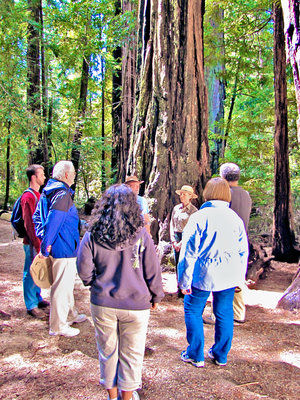As Valentine’s Day approaches, our thoughts may turn to romance and courtship, but did you know that at the same time of the year, Mother Nature has started her own dating service? Although the forests might look the same, there’s a lot of hanky-panky going on out there.
Just ask state park interpreter Susan Blake, who will lead a “Romance in the Redwoods” walk this month.
“We forget that animals are trying to attract a mate, too! And plants are also working hard to reproduce,” she said. “On this walk, we’ll meet some of the plants and animals of Big Basin and find out how they find love in the wild.”
Sitting in her cozy, 1930s CCC-built office, Susan asked recently, “Are you hearing a lot of chattering in the trees lately?”
She reports that for every female squirrel, there are two to 10 male squirrels lustily chasing after her to win her attention and a chance to mate.
“There are a lot of ‘chuk-chuk’ calls as they all yell at each other,” she said.
If you have ever used perfume or aftershave lotion to attract a mate, you have something in common with a banana slug. Susan said that “banana slugs also use a scent to find a partner — a hard thing to do when you’re a small slug in a huge redwood forest.”
She explains that “they leave a scented love note, a slime trail, when they’re ready to mate. And it doesn’t really matter who shows up — banana slugs are hermaphroditic, which means that each slug contains male and female reproductive organs.
“We’ll meet a banana slug and feel just how slimy they really are.”
She will also demonstrate how to get the slime off your fingers.
Like the banana slug, redwoods have both male and female reproductive parts.
“At this time of year, the male cones of the redwoods are releasing streams of pollen hoping the winds settle some of the pollens in female cones,” Susan said.
“But in case the resulting seeds are not successful in growing, redwoods have two other ways of reproducing. We’ll stand in an old-growth family circle of redwoods and learn about the amazing reproductive abilities of these magnificent trees.”
On the walk, she will explain what she calls the “touching love story” of moss, using magnifiers, and the “all in the family” love that acorn woodpeckers exhibit, plus many more courtship rituals.
Susan is motivated by her memories:
“The child whose face lights up as she touches a banana slug for the first time; an adult who stays after one of my programs and asks many questions because he’s been intrigued and inspired by something in my presentation; those visitors who say ‘You must love your job!’ because they see the joy and passion I have for Big Basin; and the lone encounters I’ve had with skunks, owls, banana slugs, newts and other inhabitants that I’m so lucky to share Big Basin with.”
“Romance in the Redwoods” will be an easy, two-hour walk starting at Park Headquarters at 11 a.m. Feb. 13. For information: www.bigbasin.org/activitiesmain.html.
Carol Carson, nature writer and educator, has a master’s degree in education and has been a docent at Henry Cowell Redwoods State Park. She has taught courses at UCSC Extension on Big Basin State Park. E-mail her at ca****@*********on.com.











